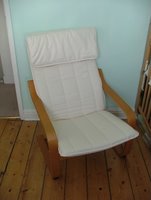 Yesterday we went down to IKEA Nottingham and back. With two adults, two children, a baby, and several items of flat-pack self-assemble furniture plus a few miscellaneous smaller items to fit in, organising ourselves for the journey home was a bit like one of those puzzles where you have to slide eight tiles around in a nine-tile-sized frame until you form the picture…
Yesterday we went down to IKEA Nottingham and back. With two adults, two children, a baby, and several items of flat-pack self-assemble furniture plus a few miscellaneous smaller items to fit in, organising ourselves for the journey home was a bit like one of those puzzles where you have to slide eight tiles around in a nine-tile-sized frame until you form the picture…IKEA furniture – perhaps epitomised by the Poang chair – has come to be omnipresent, the Home Furnishing of the hoi polloi, and as such you either love it or you hate it. I love IKEA, perhaps in part because I have enjoyed my trips to Sweden and appreciated my Swedish friends so much; but also because I like the design ethos, and many of the designs. I understand the ‘down-side’ of ‘the IKEA principle’: those who think it a shame to see furniture (in this example) divorced from local materials, local designers, the local economy; and/or who believe that just because something is good in its original context doesn’t mean it should be reproduced globally. But, I’m inclined to think that such concerns are a little naive: we can point to many historical precedents of exported design, such as the European fashion for Chinoiserie (Dutch pottery, French wallpaper, English cabinets, all in a ‘Chinese’ style); or Classical architecture, which ‘globalised’ ancient Greco-Roman forms. Moreover, what do the terms ‘local’ and ‘global’ really mean these days? Depending on the context, ‘local’ to me may mean my neighbourhood, the city I live in, the region it is in, the UK, or the European Union.
Here’s some things I like about ‘the IKEA principle’ – and might also consider relevant to the context of church/mission models:
• IKEA designers start by deciding the price tag – i.e. with a given customer profile in mind – and work from there, so that the result is a range of solutions for a range of pockets. In other words, the packages are not only applicable to / practical for a select few.
• In constructing the furniture myself, I am involved in the process of creating something that is both functionally appropriate in my own context and aesthetically pleasing, without having first to have done years of professional design training at Art College or a carpentry apprenticeship.
• The design catalogue addresses both the home and the workplace environment.
• By asking the customer to play an active part – in fetching their own furniture from the warehouse space; in clearing away their tray in the restaurant – IKEA reduce the expenses incurred by paying someone to do every job. (Of course, there are still a range of jobs for which a team is employed, as one would expect.)
• There is enough choice in the catalogue to create a combination that is individual / context-specific, while sharing the basic elements with many others.
IKEA , emerging church , church

I like the analogy. Can I add (slightly tongue in cheek):
ReplyDeleteAlthough you may way want to try to put it together by yourself, you are more likely to finish up with something that is functional, relevant and will stay together longer if it is assembled by a group!